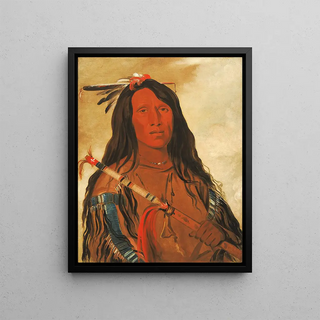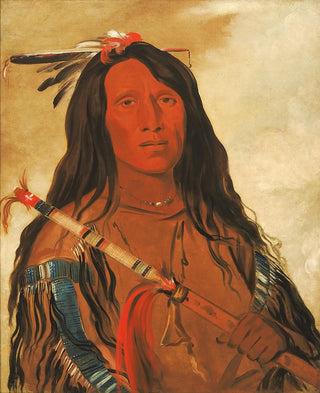Art print Nhee-ee-wo-tis Loup sur la colline Chef de la tribu - George Catlin


View from behind

Frame (optional)
The art print Nhee-ee-wo-tis Loup sur la colline Chief de la tribu - George Catlin immerses us in a pivotal moment of American history, where Native American cultures and Western explorations intersect. This iconic work, created by George Catlin, a 19th-century artist and ethnographer, depicts with rare intensity a chief of the Sioux tribe, Nhee-ee-wo-tis. The image, both majestic and poignant, evokes the grandeur of American landscapes while paying tribute to the richness of indigenous traditions. Through this painting, Catlin does not merely portray an individual; he captures the essence of a culture in full transformation, at a time when external influences began to redefine the destiny of native peoples.
Style and uniqueness of the work
George Catlin's style is distinguished by its ability to combine realism and romanticism. In this piece, the depiction of Nhee-ee-wo-tis is imbued with a dignity that transcends a simple portrait. Catlin uses vibrant colors and meticulous details to bring his subject to life. The chief, draped in traditional ornaments, is set against a landscape that evokes both wild beauty and the vastness of the lands he inhabited. The shades of green and blue in the sky and hills contrast with the earthy tones of his costume, creating a visual harmony that draws the eye. This painting is not limited to a mere illustration; it tells a story, that of a people and an era. The proud posture of Nhee-ee-wo-tis, his determined gaze, invite us to reflect on the challenges and struggles of Native tribes facing colonial expansion.
The artist and his influence
George Catlin is often regarded as the first to document Native American cultures through art. Traveling across the United States, he dedicated his life to immortalizing the customs, ceremonies, and portraits of the tribes he encountered. His artistic approach was both respectful and committed, aiming to raise awareness among the Western public about the richness

Matte finish

View from behind

Frame (optional)
The art print Nhee-ee-wo-tis Loup sur la colline Chief de la tribu - George Catlin immerses us in a pivotal moment of American history, where Native American cultures and Western explorations intersect. This iconic work, created by George Catlin, a 19th-century artist and ethnographer, depicts with rare intensity a chief of the Sioux tribe, Nhee-ee-wo-tis. The image, both majestic and poignant, evokes the grandeur of American landscapes while paying tribute to the richness of indigenous traditions. Through this painting, Catlin does not merely portray an individual; he captures the essence of a culture in full transformation, at a time when external influences began to redefine the destiny of native peoples.
Style and uniqueness of the work
George Catlin's style is distinguished by its ability to combine realism and romanticism. In this piece, the depiction of Nhee-ee-wo-tis is imbued with a dignity that transcends a simple portrait. Catlin uses vibrant colors and meticulous details to bring his subject to life. The chief, draped in traditional ornaments, is set against a landscape that evokes both wild beauty and the vastness of the lands he inhabited. The shades of green and blue in the sky and hills contrast with the earthy tones of his costume, creating a visual harmony that draws the eye. This painting is not limited to a mere illustration; it tells a story, that of a people and an era. The proud posture of Nhee-ee-wo-tis, his determined gaze, invite us to reflect on the challenges and struggles of Native tribes facing colonial expansion.
The artist and his influence
George Catlin is often regarded as the first to document Native American cultures through art. Traveling across the United States, he dedicated his life to immortalizing the customs, ceremonies, and portraits of the tribes he encountered. His artistic approach was both respectful and committed, aiming to raise awareness among the Western public about the richness
12,34 €






